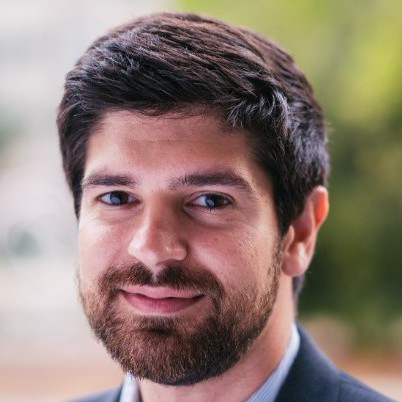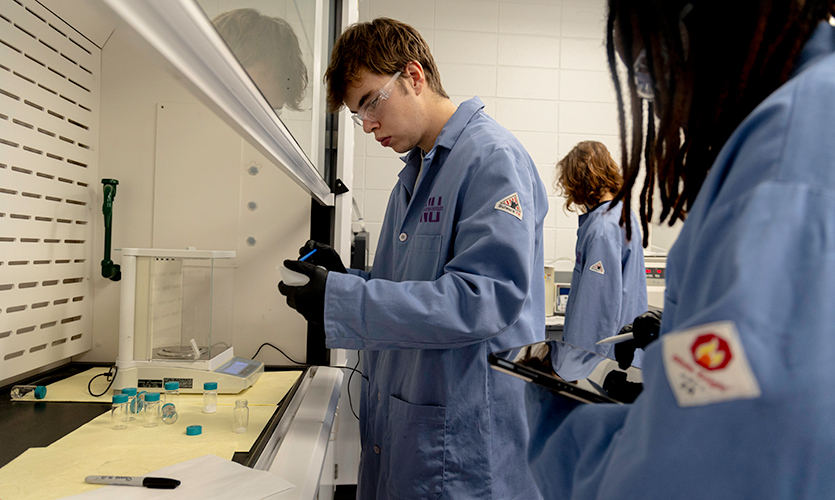Hands-On Course Prepares First-Year Students to Tackle Global Energy Challenges
MatSci 195: Materials for the Energy Solution centers on the fundamentals of energy materials
Northwestern Engineering first-year students are diving into the future of sustainability thanks to a unique course bringing energy materials to life. Taught by Raj Kumar, assistant professor of instruction in the Department of Materials Science and Engineering, MatSci 195: Materials for the Energy Solution is a hands-on class teaching students how to tackle global energy challenges.

Kumar’s course introduces students to modern and emerging energy materials such as lithium-ion batteries and perovskite solar cells. Instruction emphasizes how these materials store and harvest energy and offers a glimpse into how materials scientists and engineers work to design better batteries and solar cells.
“I wanted to create an introductory course I wish I could have taken,” Kumar said. “Coming into college, I was interested in energy and sustainability, so I was eager to give students exposure to these topics much earlier in their academic journey.”
Bridging theory with hands-on learning
When he was designing the course, Kumar wanted to provide students with more than just theoretical instruction. Using new laboratory equipment allowing students to fabricate and analyze their own batteries and solar cells, the course offers a hands-on approach to learning materials science and engineering concepts.
“Our students get to see the entire process of making a coin-cell battery,” Kumar said. “They make all of the precursors, build and assemble their own batteries, test them in the lab, and see firsthand how well they work.”
The class also highlights cutting-edge techniques, illustrated by the students’ visit to Northwestern University's Atomic and Nanoscale Characterization Experimental Center (NUANCE) to characterize their batteries under an electron microscope, gaining a deeper understanding of how materials processing impacts microstructure.
Students appreciate how the course is taught.
“Creating lithium-ion batteries and seeing the particles through the scanning electron microscope was, for me, one of the highlights,” said Adele Wilson, a first-year materials science and engineering major. “It’s a really cool opportunity to apply what we’re learning and not just hear about it.”
“By the end of the course, students not only understand the science but also acquire transferable skills,” Kumar said. “They can walk into a research lab or internship and say, ‘I know how to build and test a coin cell or a solar cell.’ That’s a leg up for future opportunities.”
Ananda Abiad, a chemical engineering major, echoed this sentiment.
“We discuss the real-life context behind what we’re learning, and seeing how what we do in the lab translates on a larger scale is really interesting,” she said.

Building a sustainable future
Kumar views the course as part of a broader vision for sustainability education at Northwestern. A former undergraduate student at the University, Kumar knows firsthand what hands-on learning can add to the college experience. He saw that for himself when he took Professor Vinayak Dravid’s course MatSci 190: MSE Freshman Projects.
“It’s surreal to now be teaching my version of the course that got me hooked on materials science,” he said.
This quarter, students extended their learning with a visit to Argonne National Laboratory.
“Seeing the machines used to create lithium-ion cells on a larger scale was fascinating,” Abiad said. “It gave us a clear picture of how our hands-on work fits into real-world applications.”
Wilson added, “It was exciting to see our knowledge of anode and cathode materials come to life. Touring facilities focused on battery recycling and energy projects reinforced the importance of sustainability.”
The course aligns with the University’s priorities in leading in decarbonization, renewable energy, and sustainability. The class also fits in with McCormick’s new strategic vision, including transforming engineering education and advancing the critical applications of engineering.
Kumar hopes the course will serve as a gateway for students across disciplines.
“We’ve had a strong response from engineering students, but I’d love to see even broader participation,” Kumar said.
Student success and aspirations
Materials for the Energy Solution’s popularity underscores its impact: 50 students signed up this fall for 25 available spots. Kumar plans to expand the course in the future.
“In the future, I’d love to open it up to more students and integrate it further into Northwestern’s energy and sustainability initiatives,” he said.
Students agree the experience has been formative.
“This class has been an amazing foundation,” Wilson said. “It validates my choice to pursue engineering and gets me excited about what’s to come.”
This class has been an amazing foundation. It validates my choice to pursue engineering and gets me excited about what’s to come.
Abiad sees it as pivotal in shaping her academic and professional interests.
“I’m now considering undergraduate research in solar cells or batteries because of this class,” she said.
Kumar’s energy and approachability have made a lasting impression on students. He balances enthusiasm and expertise with explanations that beginners can understand.
Ultimately, Kumar aims to inspire confidence in students.
“I want them to walk away thinking, ‘I know what it takes to design an experiment, analyze results, and think like a materials engineer,’” he said.
By equipping students with new skills and a materials mindset, the course prepares Northwestern engineers to tackle global challenges and create a greener future.
“Whether in policy, industry, or graduate studies, they’ll have the tools to make an impact,” Kumar said.





